Recent Advances in Optoelectronic Synaptic Devices for Neuromorphic Computing
Abstract
1. Introduction
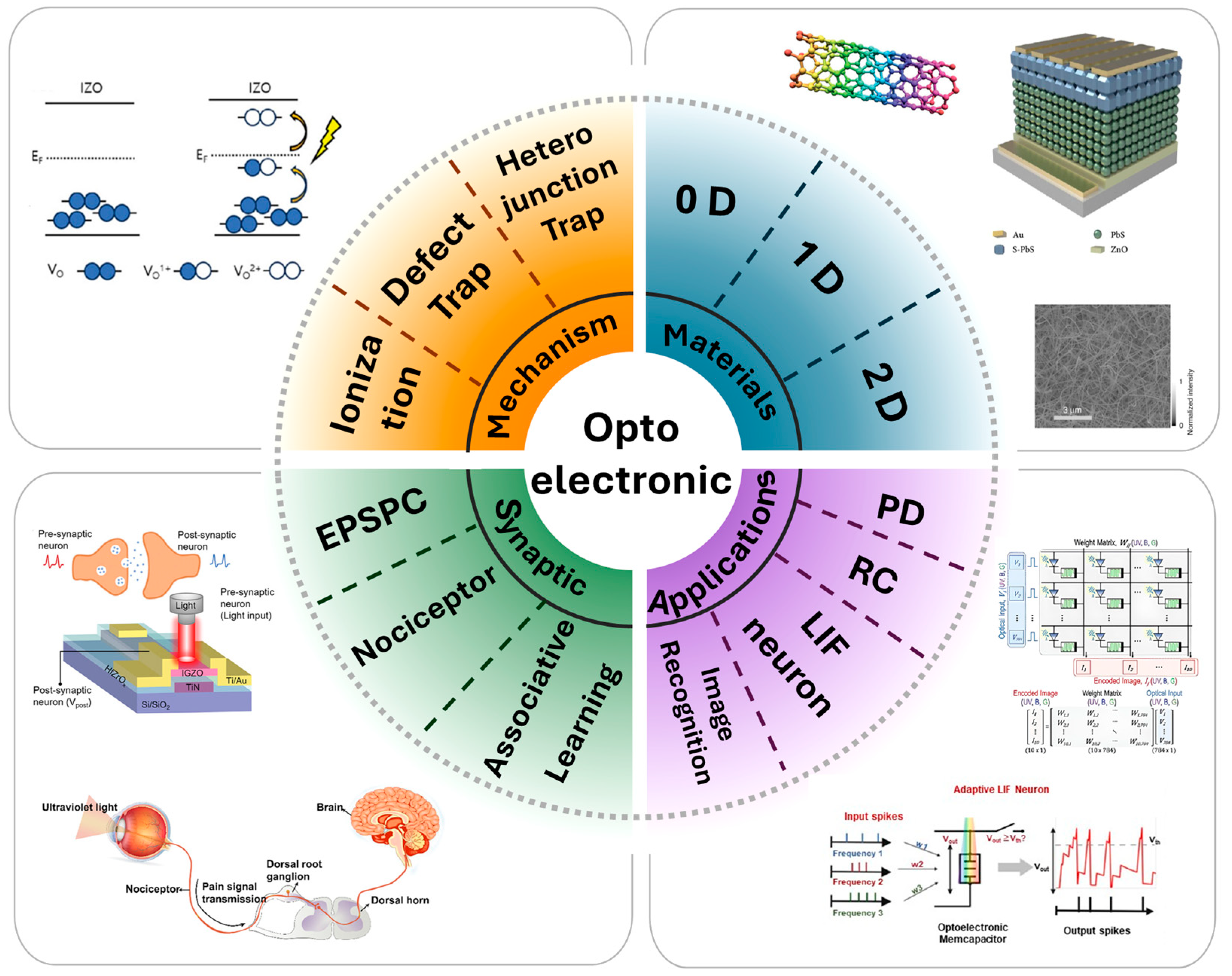
| Type | Device Structure | Availability of Stimuli | Wavelength (nm) | Synaptic Functions | Application | Energy Consumption | Ref. |
|---|---|---|---|---|---|---|---|
| ReRAM | Au/GO-TiO2/ITO | All optical | 380 nm | STP, PPF | Image sensing, sensorimotor system | 4.5 mW/cm2 | [53] |
| ReRAM | ITO/ZTO/In2O3 | Electrical/Optical | 405 nm | STM to LTM, Relearning | Mimicking human eye object tracking | 6.4 mW/cm2 | [28] |
| FET | Graphene/MoS2/ SiO2/Au/SiNx/Si | All optical | 395, 660 nm | STM to LTM, PPF | Polarization imaging system | 3.0 mW/cm2 | [54] |
| Phototransistor | MoS2/ZnO/Cr/Au | All optical | 375, 490, 525 nm | PPF, EPSC, Nociceptor, Pavlov, Logic gate | - | 2.55 × 10−9 J | [55] |
| ReRAM | PET/ITO/C60@GO/ITO/Au | All optical | 395 nm | PPF, EPSC | Memory-dependent dynamic vision recognition | 8.0 mW/cm2 | [56] |
| Three-terminal transistor | WSe2/SnSe2/Cr/Au/SiO2/Si | All optical | 400, 500, 600 nm | PPF, STM to LTM | PD MNIST | 47.5 pJ | [57] |
| ReRAM | Au/CsCu2I3/PEDOT:PSS/ITO/Glass | All optical | 445 nm | PPF, EPSC | RC, elderly fall detection | 18 nJ | [58] |
| Three-terminal transistor | Au/Mo1−xWxS2/SiO2/Si | All optical | 532 nm | PPF, Relearning | ANN for image recognition | 27.3 mW/cm2 | [59] |
| ReRAM | ITO/NiO/IGZO/Pt | All optical | 470 nm | PPF, EPSC | RC, spoken-digit recognition | 20.3 mW/cm2 | [60] |
| ReRAM | Pd/ZnO/SnSe/ITO | All optical | 405~1550 nm | Relearning, STM to LTM, Logic gate | - | 15.0 mW/cm2 | [61] |
| Three terminal transistor | Al2O3/MoS2/PTCDA/Si/SiO2 | Electrical/Optical | 532 nm | IPSC, EPSC, PPD, PPF, SRDP | dynamic filtering | 10 pJ | [62] |
| Two terminal transistor | Al/Si Nc/ITO | Electrical/Optical | 375~1870 nm | EPSC, PPF, STDP | - | 0.7 pJ | [63] |
| Two terminal transistor | ITO/ZnO QD/CdSe QD/ZnO QD/Al | Electrical/Optical | 365 nm | EPSC, PPF | Image color perception, RC | - | [64] |
| ReRAM | ITO/ZnO/HfO2/ITO | Electrical/Optical | 405 nm | MLC, Potentiation, PPF, STDP | ANN for pattern recognition | - | [65] |
| Three terminal transistor | Au/Cs2AgBiBr6/Si/SiO2 | All Optical | 532, 660 nm | PPF, PPD potentiation, depression | Digit recognition | - | [66] |
| ReRAM | Ag/Ga2O3/MoS2/ITO | Electrical/Optical | 365 nm | EPSC, PPF, STM to LTM | Perception-memory system | 180 pJ | [67] |
| Two terminal transistor | ZnO/Ag-nanowires/PET | All Optical | 365 nm | EPSC, PPF, PPD, STDP, Pavlov | - | 4 μJ | [68] |
| Three terminal transistor | Au/C3N4/PMMA/NT-CN/Si/SiO2 | All Optical | 365, 460, 520, 625 nm | EPSC, PPF | UV-transmittance modulator | 18.06 fJ | [69] |
| Three terminal transistor | ZnO/PVSK/InOx/Li-AlOx | Electrical/Optical | 465, 525, 625 nm | EPSC, PPF, | ANN for image recognition | 1.38 nJ | [70] |
| Three terminal transistor | MoS2/CdSe/ZnS/SiO2 | All Optical | 460 nm | EPSC, PPF, PPD, potentiation, depression | 62 μW/cm2 | [71] |
| Acronym | Full Name | Description |
|---|---|---|
| EPSC | Excitatory Postsynaptic Current | Postsynaptic current generated in response to excitatory input, used to quantify synaptic strength. |
| PPC | Persistent Photoconductivity | Long-lived increase in electrical conductivity after illumination is turned off. |
| STP | Short-Term Plasticity | Transient change in synaptic strength lasting from milliseconds to minutes. |
| LTP | Long-Term Plasticity | Persistent change in synaptic strength lasts from hours to days. |
| LTP | Long-Term Potentiation | Specific types of long-term plasticity characterized by increased synaptic strength. |
| LTD | Long-Term Depression | Activity-dependent reduction in synaptic strength. |
| STM | Short-Term Memory | Information storage lasts a short period, typically seconds to minutes. |
| LTM | Long-Term Memory | Information storage lasts from hours to years. |
| MeC | Memory Current | Current level representing stored conductance state in a synaptic device. |
| MeD | Memory Degree | Quantitative measure of memory retention in a synaptic device. |
| ReC | Response Current | Current generated in immediate response to a stimulus, used to assess device sensitivity. |
2. Mechanism
2.1. Ionization and Deionization of Oxygen Vacancies
2.2. Defect Traps
2.3. Heterojunction Traps
3. Materials
3.1. 0D Materials
3.2. One-Dimensional Materials
3.3. Two-Dimensional Materials
3.4. Fabrication Feasibility and Integration Challenges
4. Optically Facilitated Synaptic Properties
4.1. EPSC
4.2. Visual Adaptation and Flicker Fusion
4.3. Transition from STP to LTP
4.4. Nociceptor
4.5. Associative Learning
4.6. Reliability and Long-Term Performance
5. Applications
5.1. Potentiation and Depression for Artifitial Neural Network
5.2. Reservoir Computing Using Data Encoding Processing
5.3. Adaptive LIF Neuron
5.4. Colored Image Recognition
5.5. Emerging Application Perspectives
6. Conclusions
Author Contributions
Funding
Data Availability Statement
Conflicts of Interest
References
- Schaller, R.R. Moore’s Law: Past, Present and Future. IEEE Spectr. 1997, 34, 52–59. [Google Scholar] [CrossRef]
- Wang, H.; Yang, J.; Yang, Z.; Liu, G.; Tang, Y.; Shao, Y.; Yan, X. Optical–Electrical Coordinately Modulated Memristor Based on 2D Ferroelectric RP Perovskite for Artificial Vision Applications. Adv. Sci. 2024, 11, 2403150. [Google Scholar] [CrossRef] [PubMed]
- Huo, Q.; Yang, Y.; Wang, Y.; Lei, D.; Fu, X.; Ren, Q.; Xu, X.; Luo, Q.; Xing, G.; Chen, C.; et al. A Computing-in-Memory Macro Based on Three-Dimensional Resistive Random-Access Memory. Nat. Electron. 2022, 5, 469–477. [Google Scholar] [CrossRef]
- Zou, X.; Xu, S.; Chen, X.; Yan, L.; Han, Y. Breaking the von Neumann Bottleneck: Architecture-Level Processing-in-Memory Technology. Sci. China Inf. Sci. 2021, 64, 160404. [Google Scholar] [CrossRef]
- Xu, X.-Y.; Jin, X.-M. Integrated Photonic Computing beyond the von Neumann Architecture. ACS Photonics 2023, 10, 1027–1036. [Google Scholar] [CrossRef]
- Ju, D.; Noh, M.; Lee, S.; Kim, G.; Park, J.; Kim, S. Self-Rectifying Volatile Memristor for Highly Dynamic Functions. Adv. Funct. Mater. 2025, 35, 2423880. [Google Scholar] [CrossRef]
- Seok, H.; Lee, D.; Son, S.; Choi, H.; Kim, G.; Kim, T. Beyond von Neumann Architecture: Brain-Inspired Artificial Neuromorphic Devices and Integrated Computing. Adv. Electr. Mater. 2024, 10, 2300839. [Google Scholar] [CrossRef]
- Schuman, C.D.; Kulkarni, S.R.; Parsa, M.; Mitchell, J.P.; Date, P.; Kay, B. Opportunities for Neuromorphic Computing Algorithms and Applications. Nat. Comput. Sci. 2022, 2, 10–19. [Google Scholar] [CrossRef]
- Li, R.; Gong, Y.; Huang, H.; Zhou, Y.; Mao, S.; Wei, Z.; Zhang, Z. Photonics for Neuromorphic Computing: Fundamentals, Devices, and Opportunities. Adv. Mater. 2025, 37, 2312825. [Google Scholar] [CrossRef]
- Padamsey, Z.; Rochefort, N.L. Paying the Brain’s Energy Bill. Curr. Opin. Neurobiol. 2023, 78, 102668. [Google Scholar] [CrossRef]
- Wu, Z.; Huang, L.; Wang, M.; He, X. Development of the Brain Network Control Theory and Its Implications. Psychoradiology 2024, 4, kkae028. [Google Scholar] [CrossRef]
- Wang, Y.; Wang, G.; Yiran, S.; Ho-Ching, I.H. A Memristor Neural Network Using Synaptic Plasticity and Its Associative Memory. Circuits Syst. Signal Process. CSSP 2020, 39, 3496–3511. [Google Scholar] [CrossRef]
- Sung, S.H.; Kim, T.J.; Shin, H.; Im, T.H.; Lee, K.J. Simultaneous Emulation of Synaptic and Intrinsic Plasticity Using a Memristive Synapse. Nat. Commun. 2022, 13, 2811. [Google Scholar] [CrossRef]
- Zeng, J.; Chen, X.; Liu, S.; Chen, Q.; Liu, G. Organic Memristor with Synaptic Plasticity for Neuromorphic Computing Applications. Nanomaterials 2023, 13, 803. [Google Scholar] [CrossRef]
- Gao, L.; Ren, Q.; Sun, J.; Han, S.-T.; Zhou, Y. Memristor Modeling: Challenges in Theories, Simulations, and Device Variability. J. Mater. Chem. C 2021, 9, 16859–16884. [Google Scholar] [CrossRef]
- Thakkar, P.; Gosai, J.; Gogoi, H.J.; Solanki, A. From Fundamentals to Frontiers: A Review of Memristor Mechanisms, Modeling and Emerging Applications. J. Mater. Chem. C 2024, 12, 1583–1608. [Google Scholar] [CrossRef]
- Aguirre, F.; Sebastian, A.; Le Gallo, M.; Song, W.; Wang, T.; Yang, J.J.; Lu, W.; Chang, M.-F.; Ielmini, D.; Yang, Y.; et al. Hardware Implementation of Memristor-Based Artificial Neural Networks. Nat. Commun. 2024, 15, 1974. [Google Scholar] [CrossRef] [PubMed]
- Tian, B.-B.; Zhong, N.; Duan, C.-G. Recent Advances, Perspectives, and Challenges in Ferroelectric Synapses*. Chin. Phys. B 2020, 29, 097701. [Google Scholar] [CrossRef]
- Mehonic, A.; Ielmini, D.; Roy, K.; Mutlu, O.; Kvatinsky, S.; Serrano-Gotarredona, T.; Linares-Barranco, B.; Spiga, S.; Savel’ev, S.; Balanov, A.G.; et al. Roadmap to Neuromorphic Computing with Emerging Technologies. APL Mater. 2024, 12, 109201. [Google Scholar] [CrossRef]
- Yang, K.; Joshua Yang, J.; Huang, R.; Yang, Y. Nonlinearity in Memristors for Neuromorphic Dynamic Systems. Small Sci. 2022, 2, 2100049. [Google Scholar] [CrossRef]
- Li, X.-D.; Chen, N.-K.; Wang, B.-Q.; Li, X.-B. Conductive Mechanism in Memristor at the Thinnest Limit: The Case Based on Monolayer Boron Nitride. Appl. Phys. Lett. 2022, 121, 073505. [Google Scholar] [CrossRef]
- Park, W.; Kim, G.; Chae, H.; Lee, S.; Kim, S. HfAlOx-based optical ferroelectric memristor with transparent electrode for RGB color image classification via physical reservoir. Nano Energy 2025, 142, 111190. [Google Scholar] [CrossRef]
- Zhang, Z.; Wang, Q.; Shi, G.; Ma, Y.; Zeng, J.; Liu, G. Neural Networks Based on In-Sensor Computing of Optoelectronic Memristor. Microelectron. Eng. 2024, 291, 112201. [Google Scholar] [CrossRef]
- Mahatat, C.; Ismail, M.; Kim, H.; Kim, S. Optically Tunable Synaptic Plasticity and Memory Emulation in Au-Nanoparticle Enhanced HfTiOx/Al2O3-Based Photonic Memristors. Adv. Funct. Mater. 2025, e10663. [Google Scholar] [CrossRef]
- Lu, C.; Meng, J.; Song, J.; Wang, T.; Zhu, H.; Sun, Q.-Q.; Zhang, D.W.; Chen, L. Self-Rectifying All-Optical Modulated Optoelectronic Multistates Memristor Crossbar Array for Neuromorphic Computing. Nano Lett. 2024, 24, 1667–1672. [Google Scholar] [CrossRef]
- Wang, J.; Ilyas, N.; Ren, Y.; Ji, Y.; Li, S.; Li, C.; Liu, F.; Gu, D.; Ang, K.-W. Technology and Integration Roadmap for Optoelectronic Memristor. Adv. Mater. 2024, 36, 2307393. [Google Scholar] [CrossRef]
- Wang, X.; Zong, Y.; Liu, D.; Yang, J.; Wei, Z. Advanced Optoelectronic Devices for Neuromorphic Analog Based on Low-Dimensional Semiconductors. Adv. Funct. Mater. 2023, 33, 2213894. [Google Scholar] [CrossRef]
- Kumar, D.; Bharti, R.; Li, H.; Kumbhar, D.D.; El-Atab, N. Optoelectronic Wide-Band-Gap Oxide-Based Memristor for Mim icking Human Eye Sensory Perception and Object Tracking. Cell Rep. Phys. Sci. 2024, 5, 102144. [Google Scholar] [CrossRef]
- Fu, X.; Li, T.; Cai, B.; Miao, J.; Panin, G.N.; Ma, X.; Wang, J.; Jiang, X.; Li, Q.; Dong, Y.; et al. Graphene/MoS2−xOx/Graphene Photomemristor with Tunable Non-Volatile Responsivities for Neuromorphic Vision Processing. Light Sci. Appl. 2023, 12, 39. [Google Scholar] [CrossRef]
- Kumar, D.; Li, H.; Das, U.K.; Syed, A.M.; El-Atab, N. Flexible Solution-Processable Black-Phosphorus-Based Optoelectronic Memristive Synapses for Neuromorphic Computing and Artificial Visual Perception Applications. Adv. Mater. 2023, 35, 2300446. [Google Scholar] [CrossRef]
- Lei, P.; Duan, H.; Qin, L.; Wei, X.; Tao, R.; Wang, Z.; Guo, F.; Song, M.; Jie, W.; Hao, J. High-Performance Memristor Based on 2D Layered BiOI Nanosheet for Low-Power Artificial Optoelectronic Synapses. Adv. Funct. Mater. 2022, 32, 2201276. [Google Scholar] [CrossRef]
- Huang, H.; Liang, X.; Wang, Y.; Tang, J.; Li, Y.; Du, Y.; Sun, W.; Zhang, J.; Yao, P.; Mou, X.; et al. Fully Integrated Multi-Mode Optoelectronic Memristor Array for Diversified in-Sensor Computing. Nat. Nanotechnol. 2025, 20, 93–103. [Google Scholar] [CrossRef] [PubMed]
- Khan, R.; Rahman, N.U.; Hayat, M.F.; Ghernaout, D.; Salih, A.A.M.; Ashraf, G.A.; Samad, A.; Mahmood, M.A.; Rahman, N.; Sohail, M.; et al. Unveiling Cutting-Edge Developments: Architectures and Nanostructured Materials for Application in Optoelectronic Artificial Synapses. Nanoscale 2024, 16, 14589–14620. [Google Scholar] [CrossRef] [PubMed]
- Nam, S.; Kang, D.; Jo, J.-W.; Kang, D.-W.; Park, S.K.; Kim, Y.-H. Recent Progress of Neuromorphic Sensory and Optoelectronic Systems. Int. J. Extrem. Manuf. 2025. [Google Scholar] [CrossRef]
- Zhang, Y.; Chen, H.; Sun, W.; Hou, Y.; Cai, Y.; Huang, H. All-Photonic Synapses for Biomimetic Ocular System. Adv. Funct. Mater. 2024, 34, 2409419. [Google Scholar] [CrossRef]
- Song, S.; Kim, J.; Kwon, S.M.; Jo, J.-W.; Park, S.K.; Kim, Y.-H. Recent Progress of Optoelectronic and All-Optical Neuromorphic Devices: A Comprehensive Review of Device Structures, Materials, and Applications. Adv. Intell. Sys. 2021, 3, 2000119. [Google Scholar] [CrossRef]
- Guo, X.; Xiang, J.; Zhang, Y.; Su, Y. Integrated Neuromorphic Photonics: Synapses, Neurons, and Neural Networks. Adv. Photonics Res. 2021, 2, 2000212. [Google Scholar] [CrossRef]
- Wu, R.; Liu, X.; Yuan, Y.; Wang, Z.; Jing, Y.; Sun, J. Biomimetic Artificial Tetrachromatic Photoreceptors Based on Fully Light-Controlled 2D Transistors. Adv. Funct. Mater. 2023, 33, 2305677. [Google Scholar] [CrossRef]
- Zhao, S.; Ni, Z.; Tan, H.; Wang, Y.; Jin, H.; Nie, T.; Xu, M.; Pi, X.; Yang, D. Electroluminescent Synaptic Devices with Logic Functions. Nano Energy 2018, 54, 383–389. [Google Scholar] [CrossRef]
- Cheng, Y.; Zhang, J.; Zhou, T.; Wang, Y.; Xu, Z.; Yuan, X.; Fang, L. Photonic Neuromorphic Architecture for Tens-of-Task Lifelong Learning. Light Sci. Appl. 2024, 13, 56. [Google Scholar] [CrossRef]
- Goi, E.; Zhang, Q.; Chen, X.; Luan, H.; Gu, M. Perspective on Photonic Memristive Neuromorphic Computing. PhotoniX 2020, 1, 3. [Google Scholar] [CrossRef]
- Ji, X.; Zhao, X.; Tan, M.C.; Zhao, R. Artificial Perception Built on Memristive System: Visual, Auditory, and Tactile Sensations. Adv. Intell. Sys. 2020, 2. [Google Scholar] [CrossRef]
- Sung, M.-J.; Kim, K.-N.; Kim, C.; Lee, H.-H.; Lee, S.-W.; Kim, S.; Seo, D.-G.; Zhou, H.; Lee, T.-W. Organic Artificial Nerves: Neuromorphic Robotics and Bioelectronics. Chem. Rev. 2025, 125, 2625–2664. [Google Scholar] [CrossRef] [PubMed]
- Tossoun, B.; Liang, D.; Cheung, S.; Fang, Z.; Sheng, X.; Strachan, J.P.; Beausoleil, R.G. High-Speed and Energy-Efficient Non-Volatile Silicon Photonic Memory Based on Heterogeneously Integrated Memresonator. Nat. Commun. 2024, 15, 551. [Google Scholar] [CrossRef]
- Park, H.; Ju, D.; Mahata, C.; Emelyanov, A.; Koo, M.; Kim, S. Long- and Short-Term Memory Characteristics Controlled by Electrical and Optical Stimulations in InZnO-Based Synaptic Device for Reservoir Computing. Adv. Electron. Mater. 2024, 10, 2300911. [Google Scholar] [CrossRef]
- Kim, S.-H.; Kim, Y.-H.; Choi, J.-H.; Jeong, S.; Kim, D.; Yang, M.; Lee, S.-Y.; Kim, J.; Ahn, Y.; Kim, Y.-H.; et al. Thiol-Free p-Type Colloidal Quantum Dot for Efficient Broadband Optoelectronics. Int. J. Energy Res. 2024, 2024, 5525410. [Google Scholar] [CrossRef]
- Wang, Y.; Sun, G.; Zhang, X.; Zhang, X.; Cui, Z. Advancement in Carbon Nanotubes Optoelectronic Devices for Terahertz and Infrared Applications. Adv. Electron. Mater. 2024, 10, 2400124. [Google Scholar] [CrossRef]
- Li, D.; Lan, C.; Manikandan, A.; Yip, S.; Zhou, Z.; Liang, X.; Shu, L.; Chueh, Y.-L.; Han, N.; Ho, J.C. Ultra-Fast Photodetectors Based on High-Mobility Indium Gallium Antimonide Nanowires. Nat. Commun. 2019, 10, 1664. [Google Scholar] [CrossRef]
- Yang, P.; Xu, H.; Luo, X.; Yu, S.; Liu, Y.; Zhang, Y.; Guo, X.; Song, B.; Li, Z.; Liu, S.; et al. Tailoring Dynamic Synaptic Plasticity in FeTFT Optoelectronic Synapse for Associative Learning. Adv. Electron. Mater. 2025, 11, 2400732. [Google Scholar] [CrossRef]
- Gong, Y.; Xing, X.; Lv, Z.; Chen, J.; Xie, P.; Wang, Y.; Huang, S.; Zhou, Y.; Han, S.-T. Ultrasensitive Flexible Memory Phototransistor with Detectivity of 1.8×1013 Jones for Artificial Visual Nociceptor. Adv. Intell. Sys. 2022, 4, 2100257. [Google Scholar] [CrossRef]
- Alqahtani, B.; Li, H.; Syed, A.M.; El-Atab, N. From Light Sensing to Adaptive Learning: Hafnium Diselenide Reconfigurable Memcapacitive Devices in Neuromorphic Computing. Light Sci. Appl. 2025, 14, 30. [Google Scholar] [CrossRef]
- Yao, Y.-C.; Lee, C.-J.; Chen, Y.-J.; Feng, J.-Z.; Oh, H.; Lue, C.-S.; Sheu, J.-K.; Lee, Y.-J. All-Inorganic Perovskite Quantum-Dot Optical Neuromorphic Synapses for Near-Sensor Colored Image Recognition. Adv. Sci. 2025, 12, 2409933. [Google Scholar] [CrossRef] [PubMed]
- Tian, Q.; Sui, X.; Zhao, X.; Lin, Y.; Wang, Z.; Tao, Y.; Xu, H.; Liu, Y. An Optoelectronic Memristor Based on Proton-Involved Photoreduction for Bimodal Sensing, Memory, and Processing. Adv. Intell. Sys. 2025, 7, 2400968. [Google Scholar] [CrossRef]
- Li, Y.; Zhang, Y.; Wang, Y.; Sun, J.; You, Q.; Zhu, M.; Li, L.; Deng, T. Polarization-Sensitive Optoelectronic Synapse Based on 3D Graphene/MoS2 Heterostructure. Adv. Funct. Mater. 2024, 34, 2302288. [Google Scholar] [CrossRef]
- Li, Z.; Zou, G.; Xiao, Y.; Feng, B.; Huo, J.; Peng, J.; Sun, T.; Liu, L. MoS2/ZnO-Heterostructured Optoelectronic Synapse for Multiwavelength Optical Information-Based Sensing, Memory, and Processing. Nano Energy 2024, 127, 109733. [Google Scholar] [CrossRef]
- Liu, W.; Wang, J.; Guo, J.; Wang, L.; Gu, Z.; Wang, H.; Fang, H. Efficient Carbon-Based Optoelectronic Synapses for Dynamic Visual Recognition. Adv. Sci. 2025, 12, e2414319. [Google Scholar] [CrossRef]
- Huang, Z.; Wang, L.; Zhang, Y.; Cheng, Z.; Chen, F. Simulation of Optoelectronic Synaptic Behavior in SnSe2/WSe2 Heterojunction Transistors. ACS Appl. Electron. Mater. 2025, 7, 1906–1913. [Google Scholar] [CrossRef]
- Zhang, L.; Chen, Y.; Mao, S.; Li, Z.; Jiang, C.; Luo, C.; Lin, H.; Travas-Sejdic, J.; Peng, H. Lead-Free Halide Perovskite-Based Optoelectronic Synapse for Reservoir Computing. Chem. Eng. J. 2025, 506, 160106. [Google Scholar] [CrossRef]
- Pan, B.; Zhang, L.; Lan, S.; Hong, Y.; Liang, J.; Deng, L.; Taniguchi, T.; Watanabe, K.; Gao, X.; Xu, J.-L.; et al. General Synthesis Strategy of 2D Transition Metal Dichalcogenide Gradient Alloys for High-Performance Optoelectronic Synapses. Adv. Funct. Mater. 2025, 35, 2421337. [Google Scholar] [CrossRef]
- Song, J.; Meng, J.; Lu, C.; Wang, T.; Wan, C.; Zhu, H.; Sun, Q.; Zhang, D.W.; Chen, L. Self-Powered Optoelectronic Synaptic Device for Both Static and Dynamic Reservoir Computing. Nano Energy 2025, 134, 110574. [Google Scholar] [CrossRef]
- Guo, F.; Yu, W.; Zhang, M.; Zhang, B.; Hu, B.; Li, S.; Jiang, J.; Sun, A.; Liu, Y.; Hao, L. Dual-Mode ZnO/SnSe Heterojunction Devices with Integrated Bipolar Response Photodetectors and Artificial Optoelectronic Synapses for in-Sensor Computing. Small Methods 2025, e2402151. [Google Scholar] [CrossRef]
- Wang, S.; Chen, C.; Yu, Z.; He, Y.; Chen, X.; Wan, Q.; Shi, Y.; Zhang, D.W.; Zhou, H.; Wang, X.; et al. A MoS2/PTCDA Hybrid Heterojunction Synapse with Efficient Photoelectric Dual Modulation and Versatility. Adv. Mater. 2019, 31, 1806227. [Google Scholar] [CrossRef]
- Tan, H.; Ni, Z.; Peng, W.; Du, S.; Liu, X.; Zhao, S.; Li, W.; Ye, Z.; Xu, M.; Xu, Y.; et al. Broadband Optoelectronic Synaptic Devices Based on Silicon Nanocrystals for Neuromorphic Computing. Nano Energy 2018, 52, 422–430. [Google Scholar] [CrossRef]
- Lin, Q.; Zhu, Y.; Sun, J.; Peng, S.; Wang, Z.; You, K.; Guo, X.; Wang, Y.; Li, D.; Lin, L.; et al. A Full-Quantum-Dot Optoelectronic Memristor for In-Sensor Reservoir Computing System with Integrated Functions. Adv. Funct. Mater. 2025, 35, 2423548. [Google Scholar] [CrossRef]
- Saleem, A.; Kumar, D.; Wu, F.; Keong, L.B.; Tseng, T.-Y. An Opto-Electronic HfOx-Based Transparent Memristive Synapse for Neuromorphic Computing System. IEEE Trans. Electron Devices 2023, 70, 1351–1358. [Google Scholar] [CrossRef]
- Sun, Q.; Guo, Z.; Zhu, X.; Jiang, Q.; Liu, H.; Liu, X.; Sun, C.; Zhang, Y.; Wu, L.; Li, R.-W. Optogenetics-Inspired Manipulation of Synaptic Memory Using All-Optically Controlled Memristors. Nanoscale 2023, 15, 10050–10056. [Google Scholar] [CrossRef]
- Li, R.; Wang, W.; Li, Y.; Gao, S.; Yue, W.; Shen, G. Multi-Modulated Optoelectronic Memristor Based on Ga2O3/MoS2 Heterojunction for Bionic Synapses and Artificial Visual System. Nano Energy 2023, 111, 108398. [Google Scholar] [CrossRef]
- Kumar, M.; Kim, J.; Wong, C.-P. Transparent and Flexible Photonic Artificial Synapse with Piezo-Phototronic Modulator: Versatile Memory Capability and Higher Order Learning Algorithm. Nano Energy 2019, 63, 103843. [Google Scholar] [CrossRef]
- Park, H.-L.; Kim, H.; Lim, D.; Zhou, H.; Kim, Y.-H.; Lee, Y.; Park, S.; Lee, T.-W. Retina-Inspired Carbon Nitride-Based Photonic Synapses for Selective Detection of UV Light. Adv. Mater. 2020, 32, 1906899. [Google Scholar] [CrossRef]
- Liu, Q.; Yin, L.; Zhao, C.; Wang, J.; Wu, Z.; Lei, H.; Liu, Y.; Tian, B.; Zhang, Z.; Zhao, Z.; et al. Hybrid Mixed-Dimensional Perovskite/Metal-Oxide Heterojunction for All-in-One Opto-Electric Artificial Synapse and Retinal-Neuromorphic System. Nano Energy 2022, 102, 107686. [Google Scholar] [CrossRef]
- Sun, Y.; Ding, Y.; Xie, D.; Xu, J.; Sun, M.; Yang, P.; Zhang, Y. Optogenetics-Inspired Neuromorphic Optoelectronic Synaptic Transistors with Optically Modulated Plasticity. Adv. Opt. Mater. 2021, 9, 2002232. [Google Scholar] [CrossRef]
- Sunny, A.; Thamankar, R. Persistent Photoconductivity and Emulating Ebbinghaus Forgetting Curve via Characterization of Excitatory Synaptic Transmission in a ZnO-Based Optoelectronic Synapse with Ultra-Low Power (~fJ) Consumption. Appl. Surf. Sci. 2025, 684, 161767. [Google Scholar] [CrossRef]
- Euvrard, J.; Pournia, S.; Gunawan, O.; Mitzi, D.B. Giant Persistent Photoconductivity at Room Temperature in Sn-Based Perovskites. Appl. Phys. Lett. 2025, 126, 063302. [Google Scholar] [CrossRef]
- Wang, Z.; Lu, N.; Wang, J.; Geng, D.; Wang, L.; Yang, G. Charge Trapping and Emission Properties in CAAC-IGZO Transistor: A First-Principles Calculations. Materials 2023, 16, 2282. [Google Scholar] [CrossRef] [PubMed]
- Kaewmeechai, C.; Strand, J.; Shluger, A. Role of Local Structure in the Optical and Electronic Properties of Oxygen Vacancies in Different Crystal Phases of Ga2O3. Phys. Rev. Mater. 2024, 8, 094603. [Google Scholar] [CrossRef]
- Su, L.; Hu, Z.; Yan, T.; Zhang, X.; Zhang, D.; Fang, X. Light-Adapted Optoelectronic-Memristive Device for the Artificial Visual System. ACS Appl. Mater. Interfaces 2024, 16, 43742–43751. [Google Scholar] [CrossRef]
- Huang, B.; Lan, L.; Pan, J.; Qi, F.; Li, J.; Wang, C.; Li, Y.; Zeng, D.; Huang, J.; Xu, J.; et al. Low-Power Optoelectronic Synaptic Transistors with Multimodal Neuromorphic Computation and Retinal-Inspired Multiband Optical Binary Communication. Small Sci. 2025, 5, 2400511. [Google Scholar] [CrossRef]
- Chen, F.; Ma, T.; Zhang, T.; Zhang, Y.; Huang, H. Atomic-Level Charge Separation Strategies in Semiconductor-Based Photocatalysts. Adv. Mater. 2021, 33, 2005256. [Google Scholar] [CrossRef]
- Choi, J.; Jung, W.; Gonzalez-Carrero, S.; Durrant, J.R.; Cha, H.; Park, T. Understanding Charge Carrier Dynamics in Organic Photocatalysts for Hydrogen Evolution. Energy Environ. Sci. 2024, 17, 7999–8018. [Google Scholar] [CrossRef]
- Ma, X.; Janssen, R.A.J.; Gelinck, G.H. Trap-Assisted Charge Generation and Recombination in State-of-the-Art Organic Photodetectors. Adv. Mater. Technol. 2023, 8, 2300234. [Google Scholar] [CrossRef]
- Zhang, F.; Li, C.; Chen, Z.; Tan, H.; Li, Z.; Lv, C.; Xiao, S.; Wu, L.; Zhao, J. Large-Scale High Uniform Optoelectronic Synapses Array for Artificial Visual Neural Network. Microsyst. Nanoeng. 2025, 11, 5. [Google Scholar] [CrossRef]
- Shrivastava, S.; Chi, H.-N.; Limantoro, S.E.; Juliano, H.; Tseng, T.-Y. Fully Visible Light Controlled Neuro-Synaptic ReRAM Device Based on Metal Oxide Heterojunction. Appl. Phys. Lett. 2024, 124, 133503. [Google Scholar] [CrossRef]
- Wu, F.; Tseng, T.-Y. All-Optically Regulated ITO/Cu2O/WO3/ITO Memristor for Optoelectronic Neuromorphic Computing. ACS Appl. Electron. Mater. 2024, 6, 5212–5221. [Google Scholar] [CrossRef]
- Ercan, E.; Lin, Y.-C.; Yang, W.-C.; Chen, W.-C. Self-Assembled Nanostructures of Quantum Dot/Conjugated Polymer Hybrids for Photonic Synaptic Transistors with Ultralow Energy Consumption and Zero-Gate Bias. Adv. Funct. Mater. 2022, 32, 2107925. [Google Scholar] [CrossRef]
- Gu, L.; Li, X.; Xia, L.; Zhao, H.; Wang, B.; Li, Z.; Wang, Z.M.; Tong, X. Colloidal Quantum Dots-Based Photoelectrochemical-Type Optoelectronic Synapse. Adv. Funct. Mater. 2025, 35, 2415178. [Google Scholar] [CrossRef]
- Zhou, M.; Zhao, Y.; Gu, X.; Zhang, Q.; Zhang, J.; Jiang, M.; Lu, S. Light-Stimulated Low-Power Artificial Synapse Based on a Single GaN Nanowire for Neuromorphic Computing. Photon. Res. 2023, 11, 1667. [Google Scholar] [CrossRef]
- Shen, C.; Gao, X.; Chen, C.; Ren, S.; Xu, J.-L.; Xia, Y.-D.; Wang, S.-D. ZnO Nanowire Optoelectronic Synapse for Neuromorphic Computing. Nanotechnology 2022, 33, 065205. [Google Scholar] [CrossRef]
- Yao, J.; Wang, Q.; Zhang, Y.; Teng, Y.; Li, J.; Zhao, P.; Zhao, C.; Hu, Z.; Shen, Z.; Liu, L.; et al. Ultra-Low Power Carbon Nanotube/Porphyrin Synaptic Arrays for Persistent Photoconductivity and Neuromorphic Computing. Nat. Commun. 2024, 15, 6147. [Google Scholar] [CrossRef]
- Ma, M.; Huang, C.; Yang, M.; He, D.; Pei, Y.; Kang, Y.; Li, W.; Lei, C.; Xiao, X. Ultra-Low Power Consumption Artificial Photoelectric Synapses Based on Lewis Acid Doped WSe2 for Neuromorphic Computing. Small 2024, 20, 2406402. [Google Scholar] [CrossRef]
- An, J.; Zhang, N.; Tan, F.; Zhao, X.; Chang, C.; Lanza, M.; Li, S. Programmable Optoelectronic Synaptic Transistors Based on MoS2/Ta2NiS5 Heterojunction for Energy-Efficient Neuromorphic Optical Operation. Small 2024, 20, 2403103. [Google Scholar] [CrossRef]
- Nandi, S.; Ghosal, S.; Meyyappan, M.; Giri, P.K. Defect-Engineered 2D Bi2 Se3 -Based Broadband Optoelectronic Synapses with Ultralow Energy Consumption for Neuromorphic Computing. Mater. Horiz. 2025, 12, 4274–4288. [Google Scholar] [CrossRef]
- Zhu, C.; Liu, H.; Wang, W.; Xiang, L.; Jiang, J.; Shuai, Q.; Yang, X.; Zhang, T.; Zheng, B.; Wang, H.; et al. Optical Synaptic Devices with Ultra-Low Power Consumption for Neuromorphic Computing. Light Sci. Appl. 2022, 11, 337. [Google Scholar] [CrossRef]
- Li, Q.; Wu, K.; Zhu, H.; Yang, Y.; He, S.; Lian, T. Charge Transfer from Quantum-Confined 0D, 1D, and 2D Nanocrystals. Chem. Rev. 2024, 124, 5695–5763. [Google Scholar] [CrossRef]
- Lin, Q.; Zhu, Y.; Wang, Y.; Li, D.; Zhao, Y.; Liu, Y.; Li, F.; Huang, W. Flexible Quantum Dot Light-Emitting Device for Emerging Multifunctional and Smart Applications. Adv. Mater. 2023, 35, 2210385. [Google Scholar] [CrossRef] [PubMed]
- Pan, Y.; Wang, L.; Zhang, Y.; Su, X.; Gao, D.; Chen, R.; Huang, L.; Sun, W.; Zhao, Y.; Gao, D. Multi-Wavelength Laser Emission by Hot-Carriers Transfers in Perovskite-Graphene-Chalcogenide Quantum Dots. Adv. Opt. Mater. 2022, 10, 2201044. [Google Scholar] [CrossRef]
- Jang, E.; Jang, H. Review: Quantum Dot Light-Emitting Diodes. Chem. Rev. 2023, 123, 4663–4692. [Google Scholar] [CrossRef] [PubMed]
- Liu, Z.-S.; Wang, Y.; Zhao, F.; Li, H.-H.; Liu, W.-Z.; Shen, W.-S.; Duan, H.-W.; Wang, Y.-K.; Liao, L.-S. Liquid Bidentate Ligand for Full Ligand Coverage towards Efficient Near-Infrared Perovskite Quantum Dot LEDs. Light Sci. Appl. 2025, 14, 35. [Google Scholar] [CrossRef]
- Li, Z.; Li, B.; Wu, X.; Sheppard, S.A.; Zhang, S.; Gao, D.; Long, N.J.; Zhu, Z. Organometallic-Functionalized Interfaces for Highly Efficient Inverted Perovskite Solar Cells. Science 2022, 376, 416–420. [Google Scholar] [CrossRef]
- Wang, Y.; Yang, C.; Wang, Z.; Li, G.; Yang, Z.; Wen, X.; Hu, X.; Jiang, Y.; Feng, S.-P.; Chen, Y.; et al. A Self-Assembled 3D/0D Quasi-Core–Shell Structure as Internal Encapsulation Layer for Stable and Efficient FAPbI3 Perovskite Solar Cells and Modules. Small 2024, 20, 2306954. [Google Scholar] [CrossRef]
- Chetia, A.; Bera, J.; Betal, A.; Sahu, S. A Brief Review on Photodetector Performance Based on Zero Dimensional and Two Dimensional Materials and Their Hybrid Structures. Mater. Today Commun. 2022, 30, 103224. [Google Scholar] [CrossRef]
- Zou, T.; Choi, T.; Liu, A.; Zhu, H.; Noh, Y.-Y. Printed Quantum Dot Photodetectors for Applications from the High-Energy to the Infrared Region. Nano Energy 2024, 125, 109539. [Google Scholar] [CrossRef]
- Balamur, R.; Eren, G.O.; Kaleli, H.N.; Karatum, O.; Kaya, L.; Hasanreisoglu, M.; Nizamoglu, S. A Retina-Inspired Optoelectronic Synapse Using Quantum Dots for Neuromorphic Photostimulation of Neurons. Adv. Sci. 2024, 11, 2401753. [Google Scholar] [CrossRef] [PubMed]
- Xu, J.; Zhao, X.; Xie, D.; Lin, Y.; Wang, Z.; Li, Z.; Xu, H.; Liu, Y. Digital-Analog Integrated Optoelectronic Memristor Based on Carbon Dot for Ternary Opto-Electronic Logic and Sen-Memory Applications. Adv. Electron. Mater. 2024, 11, 2400834. [Google Scholar] [CrossRef]
- Thiele, F.; Hummel, T.; Protte, M.; Bartley, T.J. Opto-Electronic Bias of a Superconducting Nanowire Single Photon Detector Using a Cryogenic Photodiode. APL Photonics 2022, 7, 081303. [Google Scholar] [CrossRef]
- Balandin, A.A.; Kargar, F.; Salguero, T.T.; Lake, R.K. One-Dimensional van Der Waals Quantum Materials. Mater. Today 2022, 55, 74–91. [Google Scholar] [CrossRef]
- Sun, Y.; Li, B.; Liu, M.; Zhang, Z. Memristor Based on Carbon Nanotube Gelatin Composite Film as Artificial Optoelectronic Synapse for Image Processing. J. Colloid Interface Sci. 2024, 676, 249–260. [Google Scholar] [CrossRef]
- Lim, H.E.; Liu, Z.; Kim, J.; Pu, J.; Shimizu, H.; Endo, T.; Nakanishi, Y.; Takenobu, T.; Miyata, Y. Nanowire-to-Nanoribbon Conversion in Transition-Metal Chalcogenides: Implications for One-Dimensional Electronics and Optoelectronics. ACS Appl. Nano Mater. 2022, 5, 1775–1782. [Google Scholar] [CrossRef]
- Church, S.A.; Al-Abri, R.; Parkinson, P.; Saxena, D. Optical Characterisation of Nanowire Lasers. Prog. Quantum Electron. 2022, 85, 100408. [Google Scholar] [CrossRef]
- Song, J.; Cui, X.; Liu, P.; Shi, Y.; Wang, X.; Li, M.; Zhou, Y.; Yang, J.; Liu, H.; Yan, Y.; et al. Organic Nanowire Sensor with Seeing, Smelling and Heat Sensation Capabilities. Chem. Eng. J. 2024, 486, 150378. [Google Scholar] [CrossRef]
- Kumar, S.; Pratap, S.; Kumar, V.; Mishra, R.K.; Gwag, J.S.; Chakraborty, B. Electronic, Transport, Magnetic, and Optical Properties of Graphene Nanoribbons and Their Optical Sensing Applications: A Comprehensive Review. Luminescence 2023, 38, 909–953. [Google Scholar] [CrossRef]
- Ni, Y.; Zhang, S.; Sun, L.; Liu, L.; Wei, H.; Xu, Z.; Xu, W.; Xu, W. A Low-Dimensional Hybrid p-i-n Heterojunction Neuromorphic Transistor with Ultra-High UV Sensitivity and Immediate Switchable Plasticity. Appl. Mater. Today 2021, 25, 101223. [Google Scholar] [CrossRef]
- Chen, Q.; Wu, L.; Xu, J.; Xin, S.; Ge, D.; Wei, M.; Qin, Y.; Liu, Z.; Xi, Y.; Wang, F. Tunable Oxygen Vacancy Defects for High-Performance Electrolyte-Gated Synaptic Transistors. Front. Phys. 2025, 20, 64202. [Google Scholar] [CrossRef]
- Xin, S.; Wang, T.; Dou, K.; Zheng, L.; Wu, L.; Chen, Q.; Ji, S.; Ding, G.; Seeram, R.; Zhou, Y.; et al. Negative Photoconductivity in Nanowires/QDs Heterojunction Network for Neuromorphic Visual Perception. Adv. Funct. Mater. 2025, 2504250. [Google Scholar] [CrossRef]
- Yang, L.; Wang, Z.; Zhang, S.; Li, Y.; Jiang, C.; Sun, L.; Xu, W. Neuromorphic Gustatory System with Salt-Taste Perception, Information Processing, and Excessive-Intake Warning Capabilities. Nano Lett. 2023, 23, 8–16. [Google Scholar] [CrossRef]
- Martinez-Martinez, R.; Islam, M.M.; Krishnaprasad, A.; Roy, T. Graphene–Oxide Interface for Optoelectronic Synapse Application. Sci. Rep. 2022, 12, 5880. [Google Scholar] [CrossRef]
- Zhou, K.; Jia, Z.; Ma, X.-Q.; Niu, W.; Zhou, Y.; Huang, N.; Ding, G.; Yan, Y.; Han, S.-T.; Roy, V.A.L.; et al. Manufacturing of Graphene Based Synaptic Devices for Optoelectronic Applications. Int. J. Extrem. Manuf. 2023, 5, 042006. [Google Scholar] [CrossRef]
- Zhu, X.; Cai, Z.; Wu, Q.; Wu, J.; Liu, S.; Chen, X.; Zhao, Q. 2D Black Phosphorus Infrared Photodetectors. Laser Photon. Rev. 2025, 19, 2400703. [Google Scholar] [CrossRef]
- Higashitarumizu, N.; Wang, S.; Wang, S.; Kim, H.; Bullock, J.; Javey, A. Black Phosphorus for Mid-Infrared Optoelectronics: Photophysics, Scalable Processing, and Device Applications. Nano Lett. 2024, 24, 13107–13117. [Google Scholar] [CrossRef]
- Torres-Cavanillas, R.; Forment-Aliaga, A. Design of Stimuli-Responsive Transition Metal Dichalcogenides. Commun. Chem. 2024, 7, 241. [Google Scholar] [CrossRef]
- Al-Ani, I.A.M.; As’ham, K.; Klochan, O.; Hattori, H.T.; Huang, L.; Miroshnichenko, A.E. Recent Advances on Strong Light-Matter Coupling in Atomically Thin TMDC Semiconductor Materials. J. Opt. 2022, 24, 053001. [Google Scholar] [CrossRef]
- Rani, A.; Verma, A.; Chandra Yadav, B. Advancements in Transition Metal Dichalcogenides (TMDCs) for Self-Powered Photodetectors: Challenges, Properties, and Functionalization Strategies. Mater. Adv. 2024, 5, 3535–3562. [Google Scholar] [CrossRef]
- Cheng, Z.; Cao, R.; Wei, K.; Yao, Y.; Liu, X.; Kang, J.; Dong, J.; Shi, Z.; Zhang, H.; Zhang, X. 2D Materials Enabled Next-Generation Integrated Optoelectronics: From Fabrication to Applications. Adv. Sci. 2021, 8, 2003834. [Google Scholar] [CrossRef] [PubMed]
- Qiu, H.; Yu, Z.; Zhao, T.; Zhang, Q.; Xu, M.; Li, P.; Li, T.; Bao, W.; Chai, Y.; Chen, S.; et al. Two-Dimensional Materials for Future Information Technology: Status and Prospects. Sci. China Inf. Sci. 2024, 67, 160400. [Google Scholar] [CrossRef]
- Wu, E.; Tsarev, S.; Proniakova, D.; Liu, X.; Bachmann, D.; Yakunin, S.; Kovalenko, M.V.; Shorubalko, I. A CMOS-Compatible Fabrication Approach for High-Performance Perovskite Photodetector Arrays. Adv. Opt. Mater. 2025, 13, 2402979. [Google Scholar] [CrossRef]
- Zhang, C.; Park, N.-G. Materials and Methods for Cost-Effective Fabrication of Perovskite Photovoltaic Devices. Commun. Mater. 2024, 5, 194. [Google Scholar] [CrossRef]
- Seo, J.; Kim, S.; Yeo, D.; Gwak, N.; Oh, N. Pnictide-Based Colloidal Quantum Dots for Infrared Sensing Applications. Nano Converg. 2025, 12, 26. [Google Scholar] [CrossRef]
- Yun, H.J.; Lim, J.; Roh, J.; Neo, D.C.J.; Law, M.; Klimov, V.I. Solution-Processable Integrated CMOS Circuits Based on Colloidal CuInSe2 Quantum Dots. Nat. Commun. 2020, 11, 5280. [Google Scholar] [CrossRef]
- Quellmalz, A.; Wang, X.; Sawallich, S.; Uzlu, B.; Otto, M.; Wagner, S.; Wang, Z.; Prechtl, M.; Hartwig, O.; Luo, S.; et al. Large-Area Integration of Two-Dimensional Materials and Their Heterostructures by Wafer Bonding. Nat. Commun. 2021, 12, 917. [Google Scholar] [CrossRef]
- Liu, A.; Zhang, X.; Liu, Z.; Li, Y.; Peng, X.; Li, X.; Qin, Y.; Hu, C.; Qiu, Y.; Jiang, H.; et al. The Roadmap of 2D Materials and Devices Toward Chips. Nano-Micro Lett. 2024, 16, 119. [Google Scholar] [CrossRef]
- Gu, L.; Poddar, S.; Lin, Y.; Long, Z.; Zhang, D.; Zhang, Q.; Shu, L.; Qiu, X.; Kam, M.; Javey, A.; et al. A Biomimetic Eye with a Hemispherical Perovskite Nanowire Array Retina. Nature 2020, 581, 278–282. [Google Scholar] [CrossRef]
- Hahn, J.; Monavarfeshani, A.; Qiao, M.; Kao, A.H.; Kölsch, Y.; Kumar, A.; Kunze, V.P.; Rasys, A.M.; Richardson, R.; Wekselblatt, J.B.; et al. Evolution of Neuronal Cell Classes and Types in the Vertebrate Retina. Nature 2023, 624, 415–424. [Google Scholar] [CrossRef]
- Lee, T.-J.; Yun, K.-R.; Kim, S.-K.; Kim, J.-H.; Jin, J.; Sim, K.-B.; Lee, D.-H.; Hwang, G.W.; Seong, T.-Y. Realization of an Artificial Visual Nervous System Using an Integrated Optoelectronic Device Array. Adv. Mater. 2021, 33, 2105485. [Google Scholar] [CrossRef]
- Kutluyarov, R.V.; Zakoyan, A.G.; Voronkov, G.S.; Grakhova, E.P.; Butt, M.A. Neuromorphic Photonics Circuits: Contemporary Review. Nanomaterials 2023, 13, 3139. [Google Scholar] [CrossRef] [PubMed]
- Hu, L.; Zhuge, X.; Wang, J.; Wei, X.; Zhang, L.; Chai, Y.; Xue, X.; Ye, Z.; Zhuge, F. Emerging Optoelectronic Devices for Brain-Inspired Computing. Adv. Electron. Mater. 2025, 11, 2400482. [Google Scholar] [CrossRef]
- Li, J.; Xin, Y.; Sun, B.; Gu, D.; Liao, C.; Hu, X.; Wang, L.; Duan, S.; Zhou, G. Flexible Artificial Vision Computing System Based on FeOx Optomemristor for Speech Recognition. J. Semicond. 2025, 46, 012604. [Google Scholar] [CrossRef]
- Sarwat, S.G.; Moraitis, T.; Wright, C.D.; Bhaskaran, H. Chalcogenide Optomemristors for Multi-Factor Neuromorphic Computation. Nat. Commun. 2022, 13, 2247. [Google Scholar] [CrossRef]
- Lin, Z.; Chen, J.; Zheng, Z.; Lai, Q.; Liu, Z.; Liu, L.; Xiao, J.; Wang, W. Multifunctional UV Photodetect-Memristors Based on Area Selective Fabricated Ga2 S3 /Graphene/GaN van Der Waals Heterojunctions. Mater. Horiz. 2025, 12, 3091–3104. [Google Scholar] [CrossRef]
- Shan, X.; Wang, Z.; Xie, J.; Han, J.; Tao, Y.; Lin, Y.; Zhao, X.; Ielmini, D.; Liu, Y.; Xu, H. Hemispherical Retina Emulated by Plasmonic Optoelectronic Memristors with All-Optical Modulation for Neuromorphic Stereo Vision. Adv. Sci. 2024, 11, 2405160. [Google Scholar] [CrossRef]
- Jia, D.W.; Vogels, T.P.; Costa, R.P. Developmental Depression-to-Facilitation Shift Controls Excitation-Inhibition Balance. Commun. Biol. 2022, 5, 873. [Google Scholar] [CrossRef]
- Sui, N.; Ji, Y.; Li, M.; Zheng, F.; Shao, S.; Li, J.; Liu, Z.; Wu, J.; Zhao, J.; Li, L.-J. Photoprogrammed Multifunctional Optoelectronic Synaptic Transistor Arrays Based on Photosensitive Polymer-Sorted Semiconducting Single-Walled Carbon Nanotubes for Image Recognition. Adv. Sci. 2024, 11, 2401794. [Google Scholar] [CrossRef]
- Hu, Z.; Hu, Y.; Su, L.; Fang, X. Light-Adaptive Mimicking Retina with In Situ Image Memorization via Resistive Switching Photomemristor Arrays. Laser Photon. Rev. 2024, 18, 2301364. [Google Scholar] [CrossRef]
- Lamb, T.D.; Pugh, E.N. Dark Adaptation and the Retinoid Cycle of Vision. Prog. Retin. Eye Res. 2004, 23, 307–380. [Google Scholar] [CrossRef]
- Simonson, E.; Brozek, J. Flicker Fusion Frequency: Background and Applications. Physiol. Rev. 1952, 32, 349–378. [Google Scholar] [CrossRef]
- Chen, J.; Zhou, Z.; Kim, B.J.; Zhou, Y.; Wang, Z.; Wan, T.; Yan, J.; Kang, J.; Ahn, J.-H.; Chai, Y. Optoelectronic Graded Neurons for Bioinspired In-Sensor Motion Perception. Nat. Nanotechnol. 2023, 18, 882–888. [Google Scholar] [CrossRef] [PubMed]
- Chang, M.H.; Baek, H.J.; Lee, S.M.; Park, K.S. An Amplitude-Modulated Visual Stimulation for Reducing Eye Fatigue in SSVEP-Based Brain–Computer Interfaces. Clin. Neurophysiol. 2014, 125, 1380–1391. [Google Scholar] [CrossRef] [PubMed]
- Miller, N.; Leon, F.; Tan, J.; Irvin, L. Flicker: A Review of Temporal Light Modulation Stimulus, Responses, and Measures. Light. Res. Technol. 2023, 55, 5–35. [Google Scholar] [CrossRef]
- Li, C.; Zhang, X.; Chen, P.; Zhou, K.; Yu, J.; Wu, G.; Xiang, D.; Jiang, H.; Wang, M.; Liu, Q. Short-Term Synaptic Plasticity in Emerging Devices for Neuromorphic Computing. iScience 2023, 26, 106315. [Google Scholar] [CrossRef]
- Oh, S.; Kwon, O.; Seo, H.Y.; Kim, D.H.; Jeong, S.-H.; Park, H.K.; Park, W.; Cho, B. Light-Stimulated Long-Term Potentiation Behavior Enhanced in a HfO2/InGaZnO Photonic Synapse. Appl. Mater. Today 2023, 34, 101919. [Google Scholar] [CrossRef]
- Hsu, C.-C.; Shrivastava, S.; Pratik, S.; Chandrasekaran, S.; Tseng, T.-Y. ZTO/MgO-Based Optoelectronic Synaptic Memristor for Neuromorphic Computing. IEEE Trans. Electron Devices 2023, 70, 1048–1054. [Google Scholar] [CrossRef]
- Choi, Y.; Ho, D.H.; Kim, S.; Choi, Y.J.; Roe, D.G.; Kwak, I.C.; Min, J.; Han, H.; Gao, W.; Cho, J.H. Physically Defined Long-Term and Short-Term Synapses for the Development of Reconfigurable Analog-Type Operators Capable of Performing Health Care Tasks. Sci. Adv. 2023, 9, eadg5946. [Google Scholar] [CrossRef]
- Ojeda-Alonso, J.; Calvo-Enrique, L.; Paricio-Montesinos, R.; Kumar, R.; Zhang, M.-D.; Poulet, J.F.A.; Ernfors, P.; Lewin, G.R. Sensory Schwann Cells Set Perceptual Thresholds for Touch and Selectively Regulate Mechanical Nociception. Nat. Commun. 2024, 15, 898. [Google Scholar] [CrossRef]
- Lin, Y.; Wang, W.; Li, R.; Kim, J.; Zhang, C.; Kan, H.; Li, Y. Multifunctional Optoelectronic Memristor Based on CeO2/MoS2 Heterojunction for Advanced Artificial Synapses and Bionic Visual System with Nociceptive Sensing. Nano Energy 2024, 121, 109267. [Google Scholar] [CrossRef]
- Ye, C.; Xu, Y.; Dai, Z.; Zhu, Z.; Li, C.; Qian, K. Artificial Mechano-Nociceptive System Based on Transparent ITO/AlN/ITO Memristor Nociceptor Neuron. Appl. Phys. Lett. 2024, 125, 213501. [Google Scholar] [CrossRef]
- Watson, S.L.; Le, D.T.-M. Corneal Neuropathic Pain: A Review to Inform Clinical Practice. Eye 2024, 38, 2350–2358. [Google Scholar] [CrossRef]
- Wu, C.; Kim, T.W.; Guo, T.; Li, F.; Lee, D.U.; Yang, J.J. Mimicking Classical Conditioning Based on a Single Flexible Memristor. Adv. Mater. 2017, 29, 1602890. [Google Scholar] [CrossRef] [PubMed]
- Konrad, C.; Neuhoff, L.; Adolph, D.; Goerigk, S.; Herbert, J.S.; Jagusch-Poirier, J.; Weigelt, S.; Seehagen, S.; Schneider, S. Associative Learning via Eyeblink Conditioning Differs by Age from Infancy to Adulthood. Commun. Psychol. 2024, 2, 118. [Google Scholar] [CrossRef] [PubMed]
- Wang, W.; Wang, Y.; Yin, F.; Niu, H.; Shin, Y.-K.; Li, Y.; Kim, E.-S.; Kim, N.-Y. Tailoring Classical Conditioning Behavior in TiO2 Nanowires: ZnO QDs-Based Optoelectronic Memristors for Neuromorphic Hardware. Nano-Micro Lett. 2024, 16, 133. [Google Scholar] [CrossRef] [PubMed]
- Li, Y.; Shen, G. Advances in Optoelectronic Artificial Synapses. Cell Rep. Phys. Sci. 2022, 3, 101037. [Google Scholar] [CrossRef]
- Lee, S.H.; Jeon, D.; Lee, S.-N. Synaptic Plasticity and Memory Retention in ZnO–CNT Nanocomposite Optoelectronic Synaptic Devices. Materials 2025, 18, 2293. [Google Scholar] [CrossRef]
- Lee, M.; Lee, W.; Choi, S.; Jo, J.-W.; Kim, J.; Park, S.K.; Kim, Y.-H. Brain-Inspired Photonic Neuromorphic Devices Using Photodynamic Amorphous Oxide Semiconductors and Their Persistent Photoconductivity. Adv. Mater. 2017, 29, 1700951. [Google Scholar] [CrossRef]
- Cui, D.; Pei, M.; Lin, Z.; Wang, Y.; Zhang, H.; Gao, X.; Yuan, H.; Li, Y.; Zhang, J.; Hao, Y.; et al. Coexistence of Unipolar and Bipolar Resistive Switching in Optical Synaptic Memristors and Neuromorphic Computing. Chip 2025, 4, 100122. [Google Scholar] [CrossRef]
- Tanaka, G.; Yamane, T.; Héroux, J.B.; Nakane, R.; Kanazawa, N.; Takeda, S.; Numata, H.; Nakano, D.; Hirose, A. Recent Advances in Physical Reservoir Computing: A Review. Neural Netw. 2019, 115, 100–123. [Google Scholar] [CrossRef]
- Yamazaki, Y.; Kinoshita, K. Photonic Physical Reservoir Computing with Tunable Relaxation Time Constant. Adv. Sci. 2024, 11, 2304804. [Google Scholar] [CrossRef]
- Li, C.; Yu, H.; Shu, T.; Zhang, Y.; Wen, C.; Cao, H.; Xie, J.; Li, H.; Xu, Z.; Zhang, G.; et al. PZT Optical Memristors. Nat. Commun. 2025, 16, 6340. [Google Scholar] [CrossRef] [PubMed]
- Zhu, Z.; Shui, J.; Wang, T.; Meng, J. Mechanical Properties Analysis of Flexible Memristors for Neuromorphic Computing. Nano-Micro Lett. 2025, 18, 2. [Google Scholar] [CrossRef]

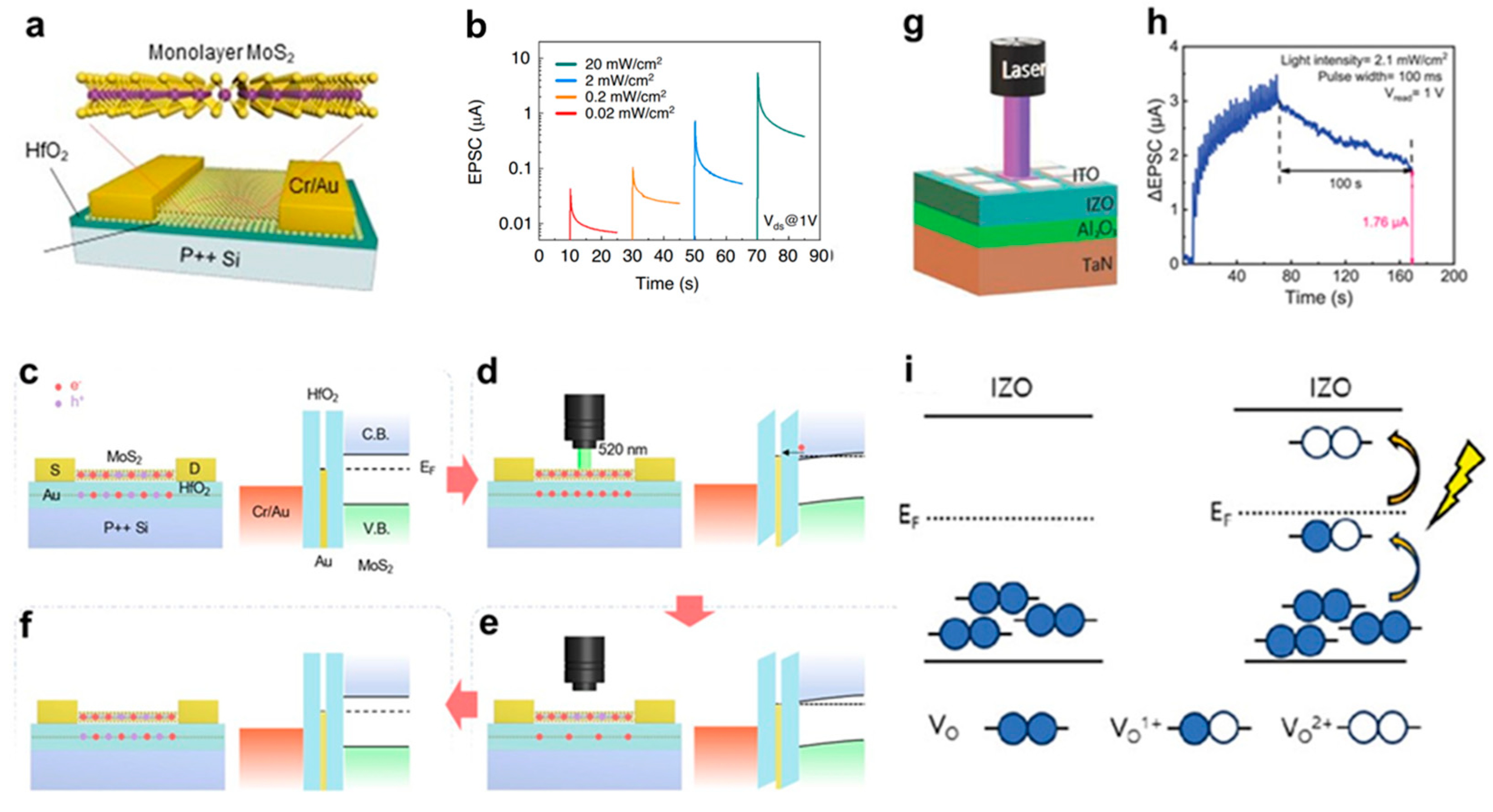
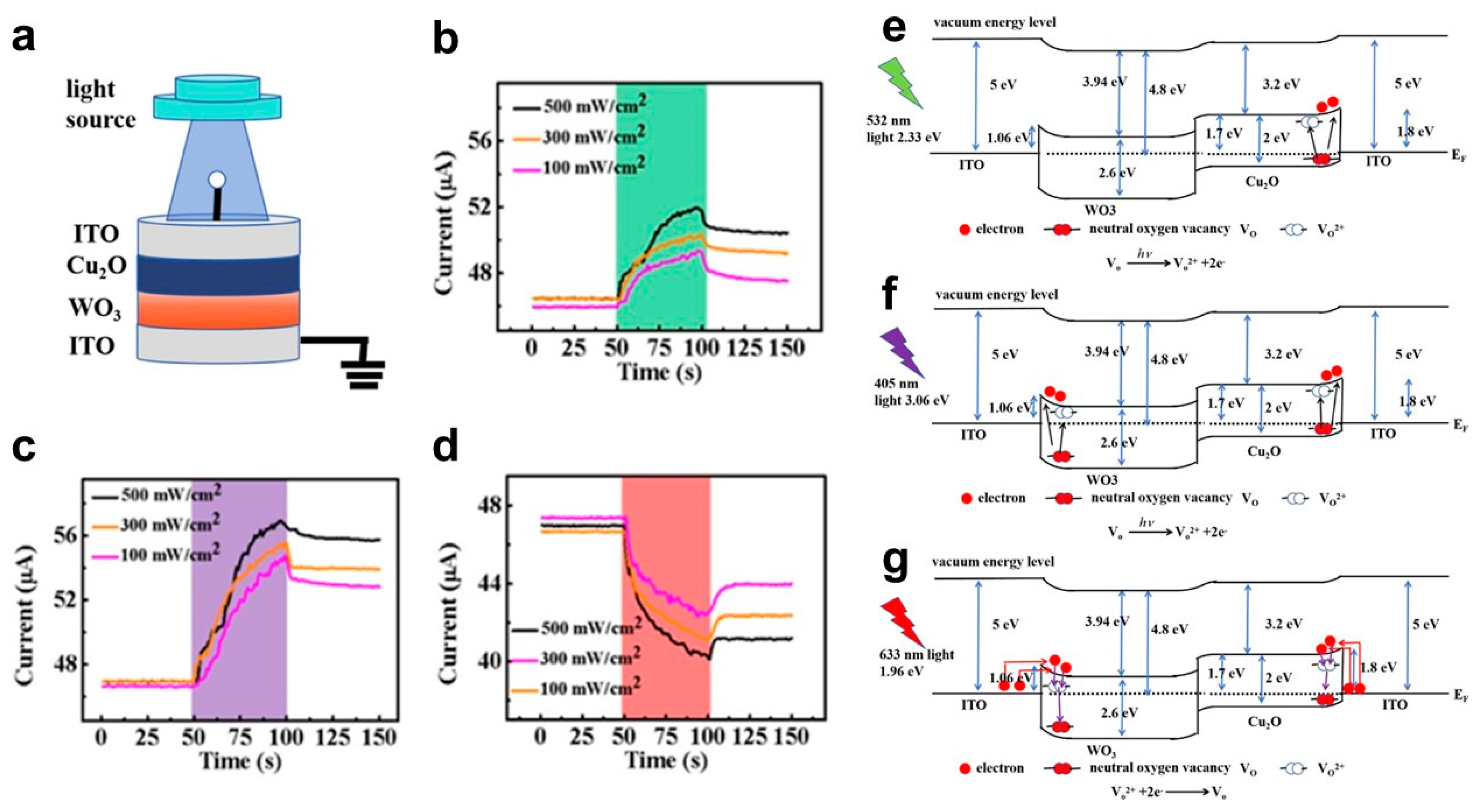

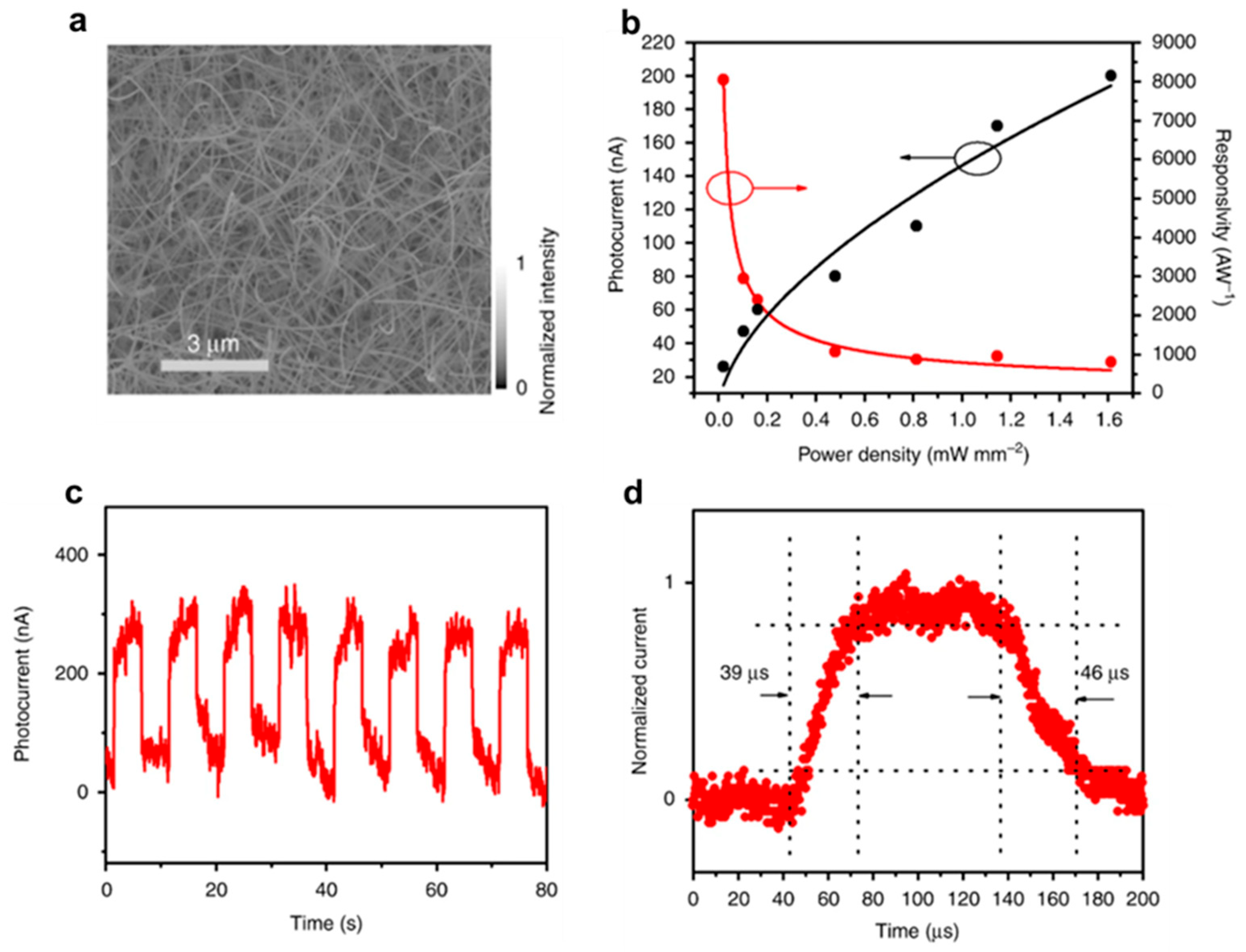

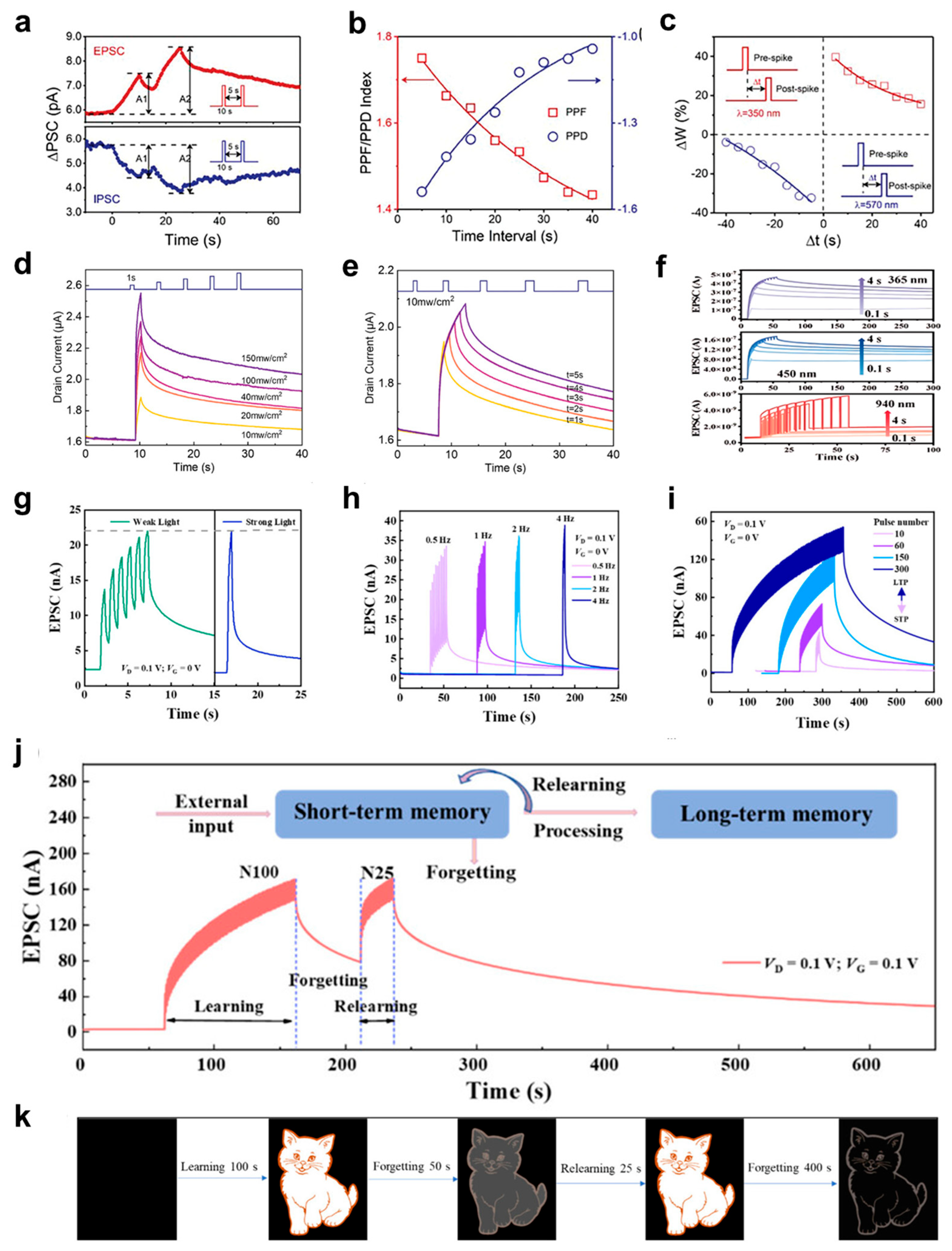
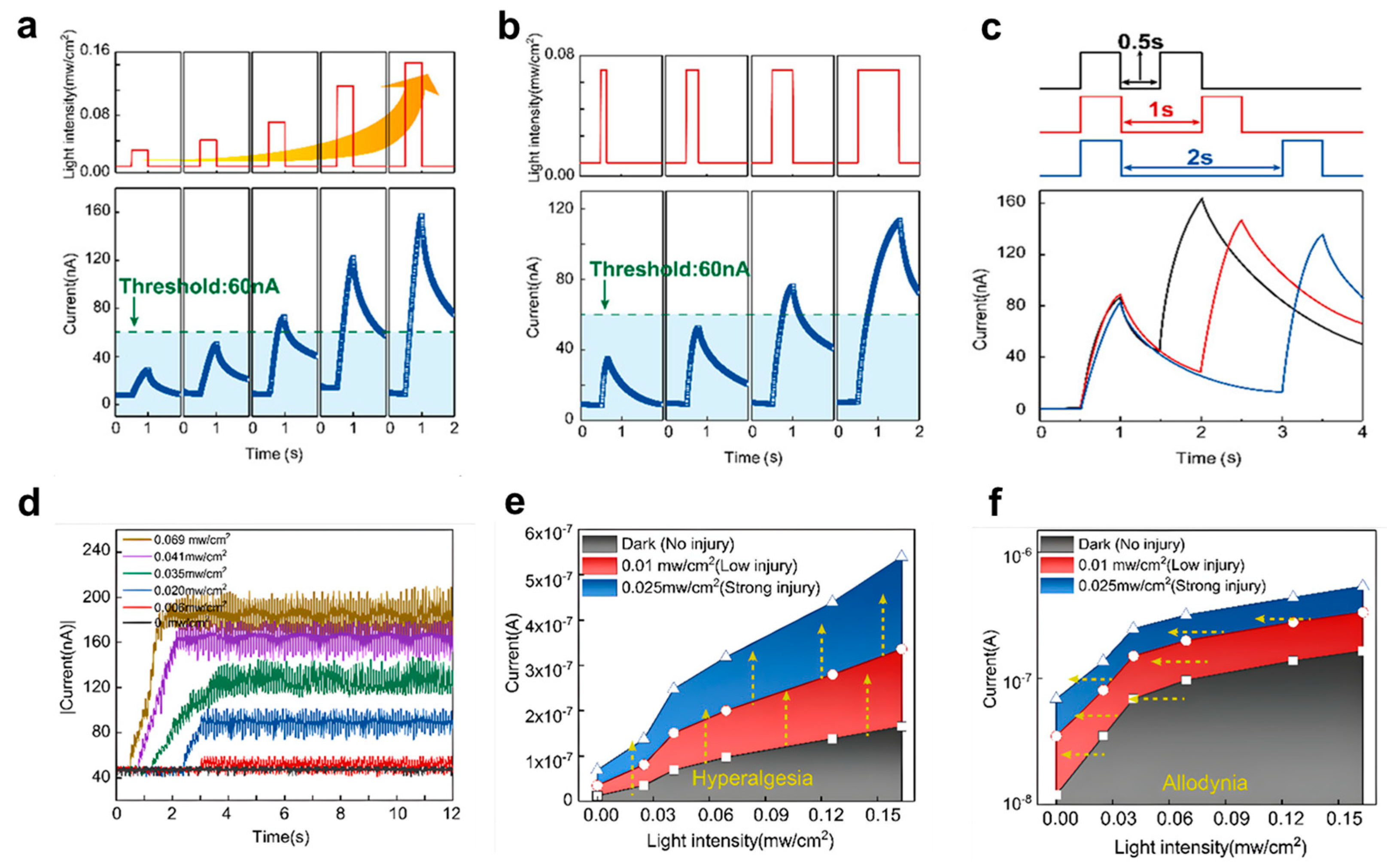


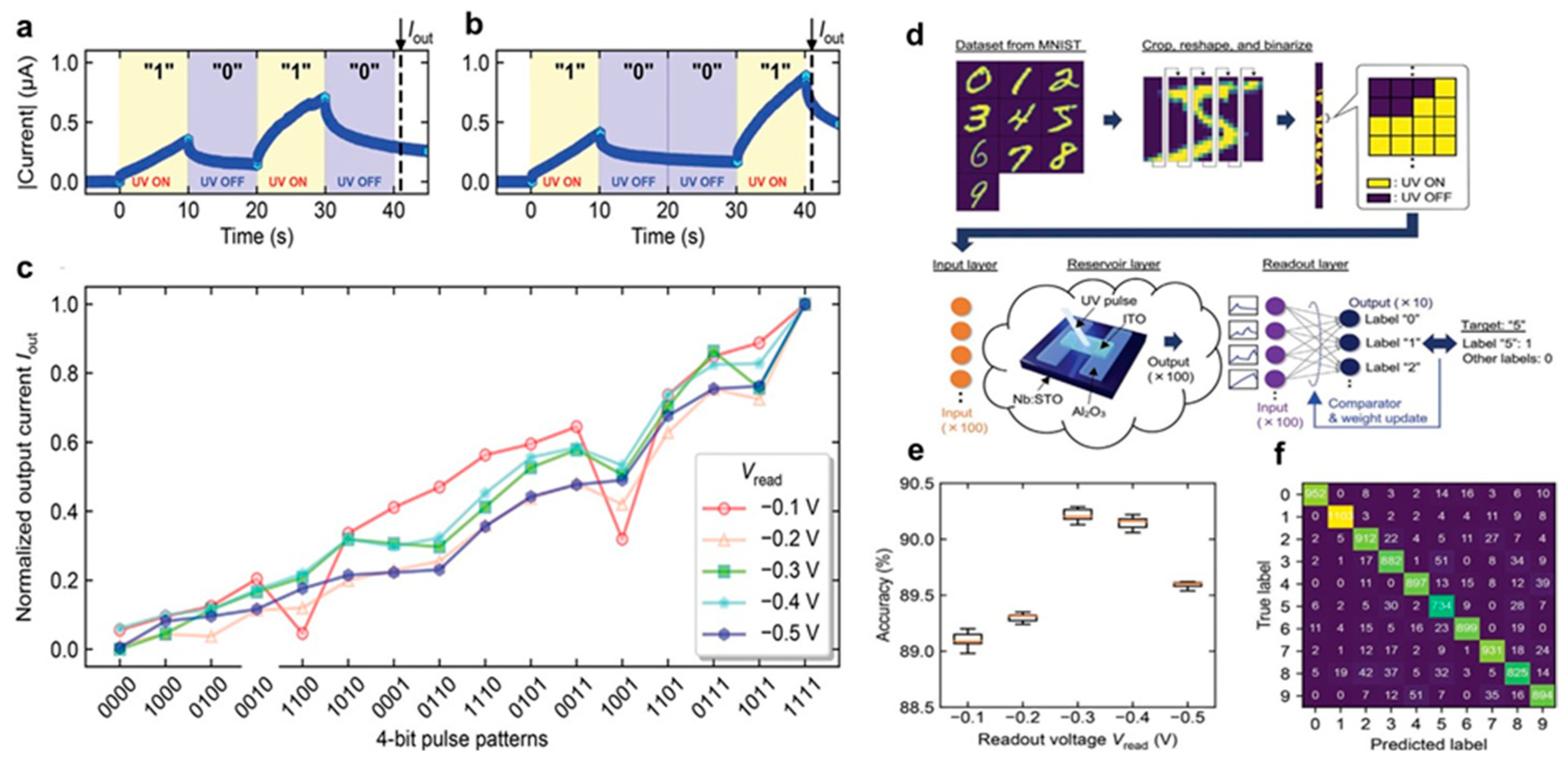

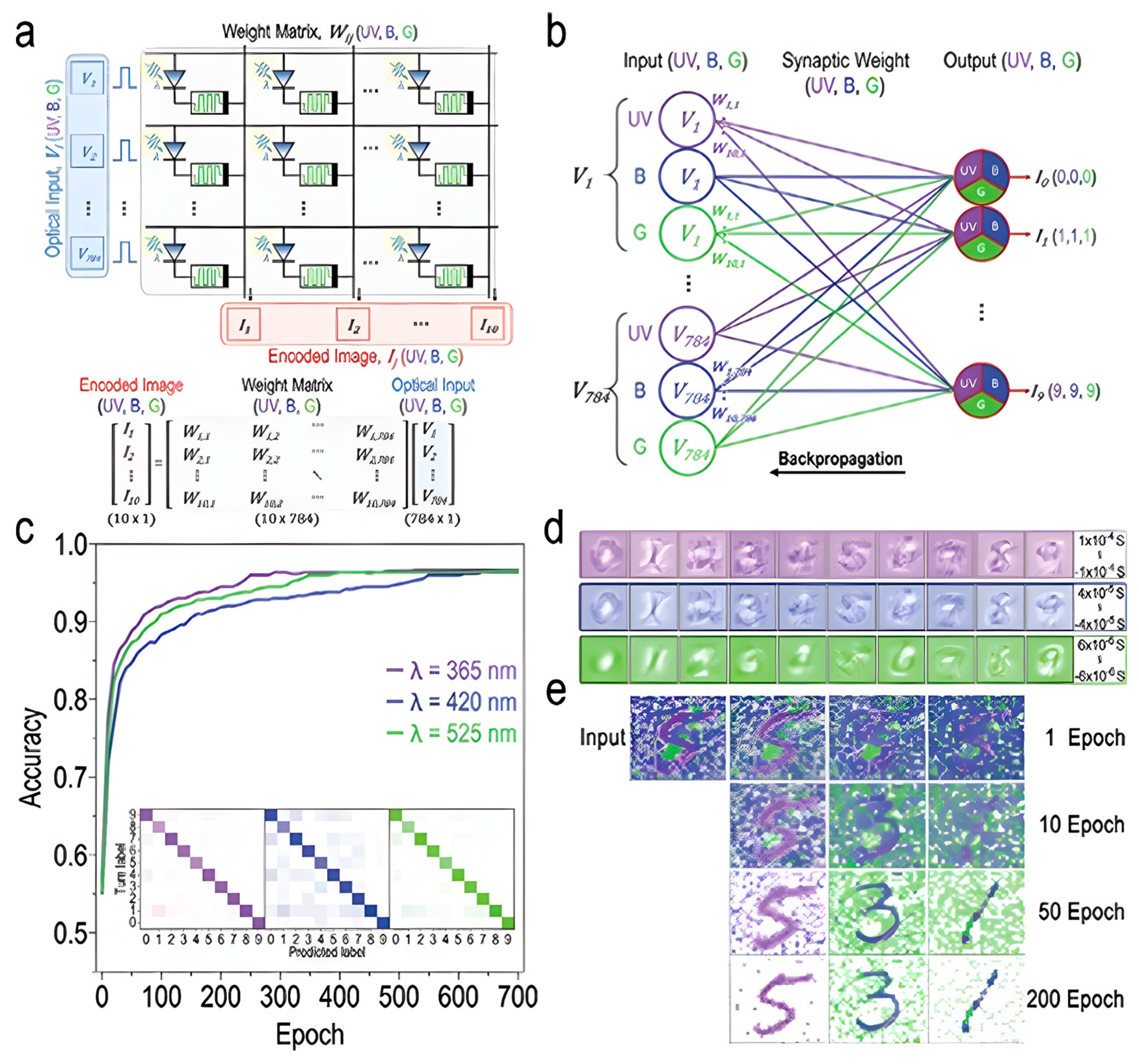
| Material | Device | λ (nm) | Optical Intensity (mW·cm−2) | EPSC Magnitude | LTP Characteristics | Energy Consumption | Ref. |
|---|---|---|---|---|---|---|---|
| 0D | P3HT–CsPbBr3 QD CNF | 450 | 0.55–11.5 | NR | >5000 s | 0.18 fJ @ V_DS = −0.001 V, 50 ms | [84] |
| 0D | CIGS/ZnSe QDs (PEC synapse) | 450 (or 570) | 0.3 | NR | decay time~102–6 × 102 s | NR | [85] |
| 1D | Single GaN nanowire | 365 | 6.11 (range 0.21–6.59) | NR | NR | 2.72 pJ (1 s, 5 V condition) | [86] |
| 1D | ZnO nanowire device | 365 | 0.099–0.134 | NR | NR | ~1 pJ (light 99 μW·cm−2, 1 s) | [87] |
| 1D | SWCNT/ZnTPP phototransistor (channel: SWCNT; absorber: ZnTPP) | 395 | 0.8–1 | 0.33 nA (200 ms, V_DS = 1 × 10−7 V)† | ≥2 × 104 s | 6.5 aJ (200 ms, V_DS = 10−7 V) | [88] |
| 2D | WSe2 (Lewis-acid doped) | 532 | 0.6 | NR | >1000 s | 0.1 fJ (min) | [89] |
| 2D | MoS2/Ta2NiS5 heterojunction transistor | 532 | NR | 117.47 nA (200 ms) | ~263 s | 17.2 fJ (V = 1 mV) | [90] |
| 2D | Bi2Se3 OES (2D thin film) | 532 | 30.2 | 14.71 nA @ 2 V (532 nm) | ~523.1 s | 9.2 fJ (200 ms, 0.01 V) | [91] |
| 2D | BP/CdS vdW photosynapse (channel: BP; photogate: CdS) | 450 | 0.00016 | ~20 μA (ΔI at that intensity) | NR | 4.78 fJ | [92] |
Disclaimer/Publisher’s Note: The statements, opinions and data contained in all publications are solely those of the individual author(s) and contributor(s) and not of MDPI and/or the editor(s). MDPI and/or the editor(s) disclaim responsibility for any injury to people or property resulting from any ideas, methods, instructions or products referred to in the content. |
© 2025 by the authors. Licensee MDPI, Basel, Switzerland. This article is an open access article distributed under the terms and conditions of the Creative Commons Attribution (CC BY) license (https://creativecommons.org/licenses/by/4.0/).
Share and Cite
Jang, H.; Ju, S.; Lee, S.; Choi, J.; Byun, U.; Min, K.; Rasheed, M.; Kim, S. Recent Advances in Optoelectronic Synaptic Devices for Neuromorphic Computing. Biomimetics 2025, 10, 584. https://doi.org/10.3390/biomimetics10090584
Jang H, Ju S, Lee S, Choi J, Byun U, Min K, Rasheed M, Kim S. Recent Advances in Optoelectronic Synaptic Devices for Neuromorphic Computing. Biomimetics. 2025; 10(9):584. https://doi.org/10.3390/biomimetics10090584
Chicago/Turabian StyleJang, Heeseong, Seohyeon Ju, Seeun Lee, Jaewoo Choi, Ungbin Byun, Kyeongjun Min, Maria Rasheed, and Sungjun Kim. 2025. "Recent Advances in Optoelectronic Synaptic Devices for Neuromorphic Computing" Biomimetics 10, no. 9: 584. https://doi.org/10.3390/biomimetics10090584
APA StyleJang, H., Ju, S., Lee, S., Choi, J., Byun, U., Min, K., Rasheed, M., & Kim, S. (2025). Recent Advances in Optoelectronic Synaptic Devices for Neuromorphic Computing. Biomimetics, 10(9), 584. https://doi.org/10.3390/biomimetics10090584






